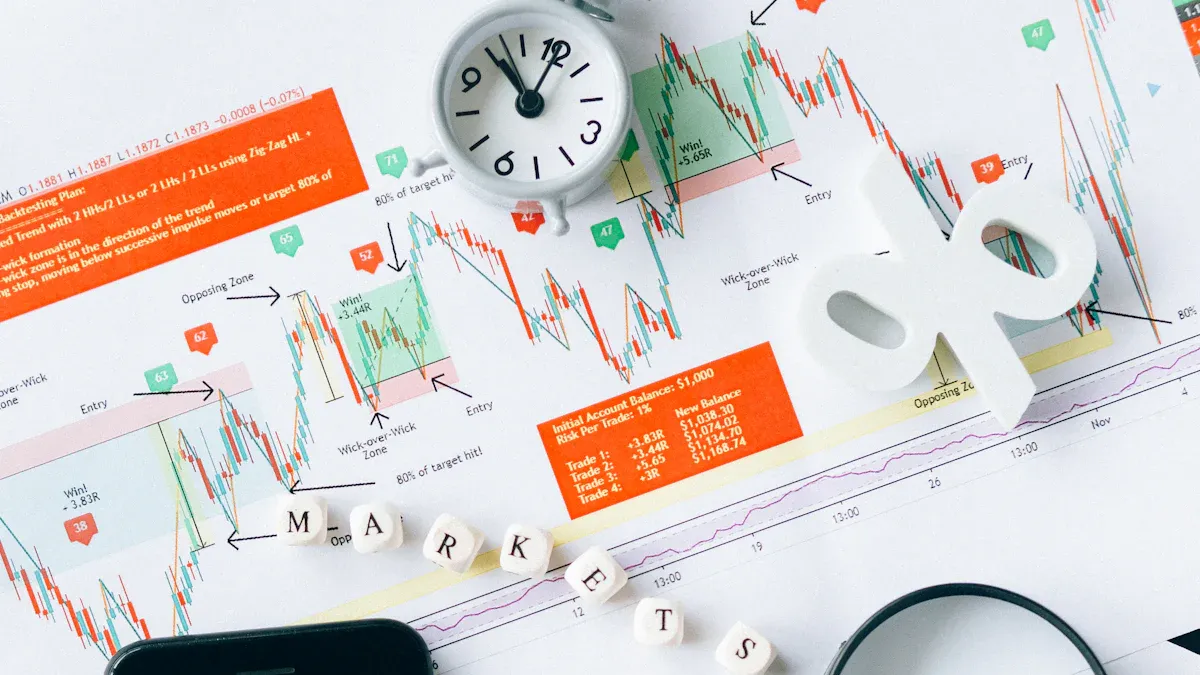Adding External Signals (Weather, Holiday) to Demand Models

Demand forecasting becomes more precise when you integrate external signals like weather and holidays. These signals capture real-world influences that historical data misses. For example, a sudden snowstorm can spike demand for winter apparel, while holidays like Christmas drive sales of gifts and decorations.
The impact of external signals on accuracy is evident in energy forecasting. Yes Energy reduced its mean absolute percentage error by 40% compared to CAISO, and its root mean square error was 45% lower. Using these signals allows you to align predictions with real-world conditions, leading to better decisions and outcomes.
Key Takeaways
Adding outside factors like weather and holidays to demand models improves predictions. This helps businesses make smarter choices.
Knowing how things like weather affect shoppers helps match stock and ads to real-life needs.
Using math models with machine learning can make forecasts better. It catches both easy patterns and tricky connections.
Updating demand models often with new outside factors keeps them useful and correct as markets change.
Begin by finding the main outside factors for your business. Slowly add them to your models to get better forecasts.
Understanding External Signals

Defining External Signals
External signals are factors outside your business that influence customer behavior and demand. These signals include weather patterns, holidays, economic trends, and even cultural events. Unlike internal data, such as past sales or inventory levels, external signals provide context about the environment in which your business operates. For example, a heatwave might increase the demand for air conditioners, while a national holiday could boost sales of party supplies.
Examples of Weather and Holiday Impacts on Demand
Weather and holidays often create noticeable shifts in consumer behavior. A snowstorm can lead to a surge in demand for winter gear, while sunny weather might increase sales of outdoor furniture. Similarly, holidays like Thanksgiving or Christmas drive demand for food, decorations, and gifts. These patterns are not random. They follow trends that you can analyze and predict. For instance, time-series analysis shows that software sales often spike in Q4 due to end-of-year budget allocations. By understanding these trends, you can align your inventory and marketing strategies with customer needs.
Evidence Description | Quantitative Trend | Impact on Demand |
|---|---|---|
Regression analysis shows a 10% increase in ad spend correlates with a 5% increase in sales conversions. | 10% increase in ad spend | 5% increase in sales conversions |
Time-series analysis indicates software sales spike in Q4 due to budget allocations. | Seasonal trend in Q4 | Anticipated increase in software sales |
Incorporating GDP forecasts and consumer sentiment data adjusts sales targets during economic downturns. | Economic indicators | Adjusted targets to mitigate revenue shortfalls |
Industries Leveraging External Signals
Many industries use external signals to refine their demand models. Retailers monitor weather forecasts to stock seasonal products. Energy companies analyze temperature changes to predict electricity usage. Social media platforms influence consumer engagement and brand awareness, shaping demand for trending products. Cultural and societal factors also play a role. For example, preferences for eco-friendly products have grown due to increased environmental awareness. Economic trends, such as recessions, affect how much consumers are willing to spend. By leveraging these signals, businesses across sectors can make smarter decisions and stay ahead of market changes.
Techniques for Integrating External Signals
Statistical Models for External Signals
Statistical models provide a structured way to incorporate external signals into demand forecasting. These models rely on mathematical equations to describe relationships between variables. For example, regression analysis can help you understand how temperature changes affect ice cream sales. Cross-validation is another useful technique. It splits your data into training and testing sets, ensuring your model performs well on unseen data. Bayesian methods are also effective. They update probabilities based on new information, making them ideal for analyzing complex datasets with external signals.
Method | Description |
|---|---|
Cross-validation | Splits data into training and testing sets to assess model performance, reducing overfitting and ensuring robustness. |
Bayesian methods | Updates prior probabilities with observed data, providing accurate uncertainty estimates and identifying false signals. |
Statistical models work well when you have smaller datasets or when the relationships between variables are straightforward. However, they may struggle to capture complex interactions between multiple external signals.
Machine Learning Approaches
Machine learning (ML) offers a powerful alternative for integrating external signals. Unlike statistical models, ML algorithms can uncover hidden patterns in large datasets. For instance, neural networks can analyze weather data and predict how it influences electricity demand. ML approaches excel at finding complex interactions between variables, even when these interactions are not pre-specified.
The concept of consolidated learning is applied in various domains, particularly in healthcare, where predictive models benefit from shared explanatory variables across datasets. This approach allows for the transfer of hyperparameters between related prediction tasks, enhancing model performance by leveraging similarities in data characteristics.
However, ML models often require larger datasets to perform well. They also lack the strong assumptions that statistical models use, which can make them more data-hungry. The table below compares statistical models and ML approaches:
Aspect | Statistical Models (SM) | Machine Learning (ML) |
|---|---|---|
Requires lower sample sizes (20 events per predictor) | Requires larger sample sizes (200 events per predictor) | |
Assumptions | Favors additivity as a default assumption | Lacks strong assumptions, can lead to 'big data' needs |
Predictive Performance | Not good at finding non-pre-specified interactions | Can find complex interactions but may not outperform SM in certain contexts |
While ML approaches are versatile, they may not always outperform statistical models, especially when the dataset is small or the relationships between variables are simple.
Combining Statistical and Machine Learning Methods
Combining statistical and machine learning methods can offer the best of both worlds. This hybrid approach leverages the strengths of each technique to improve forecasting accuracy. For example, you can use statistical models like ARIMA to identify trends and seasonality in your data. Then, you can apply machine learning algorithms like LSTM to capture complex interactions between external signals.
Recent studies highlight the effectiveness of this combined approach. For instance, integrating ARIMA with LSTM has improved the reliability of dengue predictions by utilizing both statistical trends and machine learning's ability to handle complex data. Another study focused on the automotive aftermarket demonstrated significant improvements in forecasting accuracy by combining classification models with regression techniques. This method used machine learning for feature engineering and statistical models for predicting demand quantities.
Aspect | Details |
|---|---|
Study Focus | Proposes a combined forecasting method for intermittent demand using both internal and external data. |
Methodology | Utilizes machine learning for feature engineering, classification models for predicting demand occurrence, and regression models for predicting non-zero demand quantities. |
Optimization Techniques | Introduces two combination forecasting optimization methods based on classification threshold searching and transfer learning. |
Evaluation | Validated using real data from the automotive aftermarket, showing significant improvements in classification accuracy and forecasting precision compared to traditional methods. |
Conclusion | Supports the effectiveness of combined forecasting frameworks in enhancing demand forecasting accuracy, particularly when integrating external signals. |
By combining these methods, you can create a robust demand model that adapts to various scenarios. This approach ensures that your model captures both the simplicity of statistical relationships and the complexity of machine learning patterns.
Preparing External Signals for Demand Models
Collecting Relevant External Data
To prepare external signals for your demand models, you first need to gather the right data. Start by identifying the external factors that influence your business. For example, weather data, holiday calendars, and economic indicators are common sources. You can collect weather data from meteorological services, while holiday schedules are often available through public records or online APIs. Economic trends can be sourced from government reports or financial institutions.
When collecting data, ensure it aligns with your business needs. For instance, if you sell seasonal products, focus on weather patterns and holidays. If your business depends on consumer spending, track economic indicators like GDP or consumer sentiment. Reliable sources and consistent data collection methods are crucial for building accurate demand models.
Cleaning and Preprocessing External Signals
Raw data often contains errors or inconsistencies. Cleaning and preprocessing ensure the external signals you use are reliable. Techniques like data imputation fill in missing values, while noise reduction removes irrelevant fluctuations. For example, smoothing methods can clarify weather data by eliminating random spikes.
The table below highlights common preprocessing techniques:
Preprocessing Technique | Description |
|---|---|
Data Imputation | Filling in missing values with statistical measures like mean or median to avoid skewed analysis. |
Noise Reduction | Techniques like smoothing and filtering help clarify the signal in data by removing noise. |
Identify and Remove Duplicates | Ensures each data point is unique, maintaining dataset integrity by removing duplicates. |
Feature Engineering | Creating new features from existing data to unlock insights, such as calculating BMI from weight and height. |
Feature Scaling or Normalization | Rescales features to a uniform range to prevent any single feature from dominating the model. |
Preprocessing improves data quality, making your demand models more accurate and reliable.
Merging External Signals with Historical Data
Once your external signals are ready, you need to merge them with historical data. This step creates a unified dataset that combines past trends with external influences. For example, integrating weather data with sales records can reveal how temperature changes affect demand. Similarly, merging holiday calendars with transaction data helps identify seasonal patterns.
Studies show that combining multiple data sources improves model performance. For instance, the FDA's Real-World Evidence Program highlights how merging real-world data with clinical trial records enhances data quality. Techniques like propensity scoring reduce bias and improve comparability between datasets. By applying similar methods, you can ensure your external signals align seamlessly with historical data, creating a robust foundation for demand forecasting.
Benefits of Using External Signals

Enhanced Forecast Accuracy
Integrating external signals into your demand models significantly improves forecast accuracy. These signals, such as weather patterns or holiday schedules, provide context that historical data alone cannot capture. For example, knowing how a heatwave impacts air conditioner sales allows you to predict demand more precisely. Improved accuracy reduces errors and helps you make better decisions.
Performance metrics validate these enhancements. The table below highlights key metrics used to measure forecast accuracy:
Metric | Description |
|---|---|
Mean Absolute Error (MAE) | Measures the average magnitude of errors between forecasted and actual values. |
Mean Absolute Percentage Error (MAPE) | Expresses forecast error as a percentage for easy comparison. |
Mean Squared Error (MSE) | Penalizes larger errors more heavily, emphasizing significant misses. |
Root Mean Squared Error (RMSE) | Provides a measure in the same units as the original data, emphasizing larger errors. |
Tracking Signal | Monitors forecast bias, identifying systematic over or under-forecasting. |
These metrics show how external signals refine predictions, ensuring your forecasts align with real-world conditions.
Better Inventory and Resource Management
Accurate demand forecasts lead to better inventory and resource management. External signals help you anticipate shifts in demand, allowing you to stock the right products at the right time. For instance, tracking weather data can guide you in preparing for seasonal spikes, such as increased demand for umbrellas during rainy periods. This reduces overstocking and minimizes stockouts, saving costs and improving customer satisfaction.
Resource allocation also benefits from external signals. By understanding demand patterns, you can optimize staffing levels and distribution schedules. This ensures your resources are used efficiently, avoiding waste and maximizing productivity.
Improved Marketing and Promotion Strategies
External signals enhance your marketing and promotion strategies by aligning them with consumer behavior. Holidays, for example, create opportunities for targeted campaigns. Knowing when demand peaks for specific products allows you to schedule promotions effectively. For instance, offering discounts on winter clothing during a snowstorm can boost sales.
Weather data also influences advertising strategies. Sunny days might encourage outdoor activities, making it the perfect time to promote patio furniture or sports equipment. By leveraging external signals, you can create campaigns that resonate with your audience, driving engagement and increasing conversions.
Steps to Start Using External Signals
Identifying Key External Signals for Your Business
To begin integrating external signals into your demand models, you need to identify the signals that matter most to your business. Start by analyzing the factors that influence your customers' purchasing decisions. For example, if you operate in retail, weather patterns and holiday schedules might significantly impact demand. In contrast, regulatory changes or cultural trends could be more relevant for industries like healthcare or technology.
A deeper understanding of external indicators can help you prioritize. The table below highlights some common types of external signals and their relevance:
Type of External Indicator | Description |
|---|---|
Regulatory Indicators | Changes to laws or rules that require organizations to alter products or services for compliance. |
Cultural Indicators | Societal shifts that influence consumer preferences, such as the growing demand for eco-friendly products. |
Data Indicators | Insights into customer habits that predict buying behavior, helping businesses adapt to market changes. |
Nearly half of companies already use external data in their analytics activities. Industries like financial services, logistics, and retail are leading the way. By identifying the right signals, you can align your strategies with market dynamics and gain a competitive edge.
Choosing the Right Tools and Techniques
Once you’ve identified the key external signals, the next step is selecting the tools and techniques to integrate them into your demand models. Start by evaluating your current data infrastructure. Does it support the inclusion of external data sources? If not, consider upgrading to platforms that allow seamless integration.
Many businesses use advanced analytics tools to process external signals. For instance, machine learning algorithms can analyze large datasets to uncover hidden patterns. Statistical models, on the other hand, are ideal for smaller datasets or simpler relationships. Combining these approaches often yields the best results, as it balances the strengths of both methods.
Additionally, external credit reports and ratings can enhance your decision-making. Agencies like Dun & Bradstreet provide credit scores that validate internal analyses and reveal potential risks. This information is particularly useful for managing inventory and supplier relationships. By leveraging the right tools, you can transform raw data into actionable insights.
Testing and Refining Your Demand Models
Testing and refining your demand models is crucial for ensuring their accuracy and reliability. Begin by implementing iterative testing protocols. For example, A/B testing different forecasting methods can help you determine which approach works best for your business. Continuous monitoring allows you to adapt to market dynamics, ensuring your models remain relevant over time.
Collaboration across departments also plays a key role. Sales, marketing, and supply chain teams should work together to refine demand signals. This cross-functional approach ensures that all perspectives are considered, leading to more accurate forecasts.
Financial reports can further guide your refinement process. The cash flow statement, for instance, highlights operating cash flow and changes in working capital. This insight helps you assess the financial impact of your demand forecasts. By combining financial analysis with external signals, you can make strategic adjustments to inventory and resource management.
Tip: Treat your demand models as living systems. Regular updates and refinements will keep them aligned with real-world conditions, maximizing their effectiveness.
External signals like weather and holidays transform demand forecasting by adding real-world context to your models. They improve accuracy, streamline operations, and enable smarter decisions.
Businesses using external data, such as social media trends and economic indicators, report better marketing strategies and enhanced forecasting outcomes.
These signals enrich traditional models, helping you stay ahead of market changes.
Start small by identifying key signals for your industry. Gradually integrate them into your models to unlock their full potential. The results will speak for themselves.
FAQ
What are external signals, and why are they important for demand forecasting?
External signals are factors outside your business, like weather or holidays, that influence customer behavior. They add real-world context to your demand models, improving accuracy and helping you predict shifts in demand more effectively.
How do I choose the right external signals for my business?
Focus on signals that directly impact your industry. For example, retailers might prioritize weather and holidays, while financial services could track economic trends. Start small by identifying one or two key signals and expand as you see results.
Can small businesses benefit from using external signals?
Yes! Small businesses can use free or low-cost data sources, like public weather APIs or holiday calendars, to improve their forecasts. Even simple integrations can help you better align inventory, staffing, and marketing with customer needs.
What tools can I use to integrate external signals into my models?
You can use tools like Python, R, or platforms like Tableau and Power BI. Machine learning libraries like TensorFlow or scikit-learn also help analyze complex datasets. Choose tools that fit your technical expertise and business scale.
How often should I update my demand models with external signals?
Update your models regularly to reflect current conditions. For example, weather data might require daily updates, while holiday schedules can be reviewed annually. Frequent updates ensure your forecasts stay accurate and relevant.
See Also
Exploring Weather's Impact on Demand Across Various Sectors
Effective Strategies for Weekly Retail Demand Forecasting
Understanding Short-Term Demand Forecasting Techniques and Challenges
Enhancing Forecast Precision Using Hierarchical Time-Series Approaches
Five Key Attribution Models for Optimizing Retail Marketing Budget

